Synthesis, Characterization and Application of Amine-Functionalized Hierarchically Micro-Mesoporous Silicon Composites for CO2 Capture in Flue Gas
Abstract
:1. Introduction
2. Materials and Methods
2.1. Materials
2.2. Sample Preparation
2.2.1. Synthesis of Support Material
2.2.2. Preparation of Amine-Functionalized Hierarchically Micro-Mesoporous Adsorbent
2.3. Characterization
2.4. Adsorption/Desorption of CO2
2.5. Adsorption/Desorption Kinetic Models
3. Results and Discussions
3.1. Characterization of the AMMS
3.1.1. XRD Analysis
3.1.2. SEM Analysis
3.1.3. BET Analysis
3.1.4. TG Analysis
3.1.5. FTIR Analysis
3.2. Adsorption Properties Analysis
3.3. Adsorption/Desorption Kinetics Analysis
3.4. Cyclic CO2 Adsorption/Desorption Behavior of the AMMS-T
4. Conclusions
Supplementary Materials
Author Contributions
Funding
Institutional Review Board Statement
Informed Consent Statement
Data Availability Statement
Conflicts of Interest
References
- NOAA (National Ocean and Atmospheric Administration); Earth System Research Laboratory (ESRL). Global Monitoring Division. Available online: https://gml.noaa.gov/ccgg/ (accessed on 1 May 2022).
- Bhatia, S.K.; Bhatia, R.K.; Jeon, J.M.; Kumar, G.; Yang, Y.H. Carbon Dioxide Capture and Bioenergy Production Using Biological System—A Review. Renew. Sustain. Energy Rev. 2019, 08, 143–158. [Google Scholar] [CrossRef]
- Herzog, H. Advanced Post-Combustion CO2 Capture. Work 2009, 1, 39. [Google Scholar]
- Mac Dowell, N.; Fennell, P.S.; Shah, N.; Maitland, G.C. The Role of CO2 Capture and Utilization in Mitigating Climate Change. Nat. Clim. Chang. 2017, 7, 243–249. [Google Scholar] [CrossRef] [Green Version]
- Song, C.; Liu, Q.; Ji, N.; Deng, S.; Zhao, J.; Li, Y.; Song, Y.; Li, H. Alternative Pathways for Efficient CO2 Capture by Hybrid Processes—A Review. Renew. Sustain. Energy Rev. 2018, 82, 215–231. [Google Scholar] [CrossRef]
- Hu, X.E.; Liu, L.; Luo, X.; Xiao, G.; Shiko, E.; Zhang, R.; Fan, X.; Zhou, Y.; Liu, Y.; Zeng, Z.; et al. A Review of N-Functionalized Solid Adsorbents for Post-Combustion CO2 Capture. Appl. Energy 2020, 260, 114244. [Google Scholar] [CrossRef]
- Jaffary, B.; Jaafari, L.; Idem, R. CO2 Capture Performance Comparisons of Polyamines at Practical Concentrations for Use as Activators for Methyldiethanolamine for Natural Gas Sweetening. Energy Fuels 2021, 35, 8081–8094. [Google Scholar] [CrossRef]
- Raganati, F.; Miccio, F.; Ammendola, P. Adsorption of Carbon Dioxide for Post-combustion Capture: A Review. Energy Fuels 2021, 35, 12845–12868. [Google Scholar] [CrossRef]
- Embaye, A.S.; Martínez-Izquierdo, L.; Malankowska, M.; Téllez, C.; Coronas, J. Poly(ether-block-amide) Copolymer Membranes in CO2 Separation Applications. Energy Fuels 2021, 35, 17085–17102. [Google Scholar] [CrossRef]
- Liu, M.; Hohenshil, A.; Gadikota, G. Integrated CO2 Capture and Removal via Carbon Mineralization with Inherent Regeneration of Aqueous Solvents. Energy Fuels 2021, 35, 8051–8068. [Google Scholar] [CrossRef]
- Hughes, R.; Kotamreddy, G.; Ostace, A.; Bhattacharyya, D.; Siegelman, R.L.; Parker, S.T.; Didas, S.A.; Long, J.R.; Omell, B.; Matuszewski, M. Isotherm, Kinetic, Process Modeling, and Techno-Economic Analysis of a Diamine-Appended Metal–Organic Framework for CO2 Capture Using Fixed Bed Contactors. Energy Fuels 2021, 35, 6040–6055. [Google Scholar] [CrossRef]
- Chen, Y.; Long, Y.; Sun, J.; Bai, S.; Chen, Y.; Chen, Z.; Zhao, C. Core-in-Shell, Cellulose-Templated CaO-Based Sorbent Pellets for CO2 Capture at Elevated Temperatures. Energy Fuels 2021, 35, 13215–13223. [Google Scholar] [CrossRef]
- Alghamdi, T.; Baamran, K.S.; Okoronkwo, M.U.; Rownaghi, A.A.; Rezaei, F. Metal-Doped K–Ca Double Salts with Improved Capture Performance and Stability for High-Temperature CO2 Adsorption. Energy Fuels 2021, 35, 4258–4266. [Google Scholar] [CrossRef]
- Balou, S.; Babak, S.E.; Priye, A. Synergistic Effect of Nitrogen Doping and Ultra-Microporosity on the Performance of Biomass and Microalgae-Derived Activated Carbons for CO2 Capture. ACS Appl. Mater. Interfaces 2020, 12, 42711–42722. [Google Scholar] [CrossRef] [PubMed]
- Cai, W.; Ding, J.; He, Y.; Chen, X.; Yuan, D.; Chen, C.; Cheng, L.; Du, W.; Wan, H.; Guan, G. Nitrogen-Doped Microporous Carbon Prepared by One-Step Carbonization: Rational Design of a Polymer Precursor for Efficient CO2 Capture. Energy Fuels 2021, 35, 8857–8867. [Google Scholar] [CrossRef]
- Li, J.; Zhang, W.; Bao, A. Design of Hierarchically Structured Porous Boron/Nitrogen-Codoped Carbon Materials with Excellent Performance for CO2 Capture. Ind. Eng. Chem. Res. 2021, 60, 2710–2718. [Google Scholar] [CrossRef]
- Luzzi, E.; Aprea, P.; de Luna, M.; Caputo, D.; Filippone, G. Mechanically Coherent Zeolite 13X/Chitosan Aerogel Beads for Effective CO2 Capture. ACS Appl. Mater. Interfaces 2021, 13, 20728–20734. [Google Scholar] [CrossRef]
- Rosu, C.; Pang, S.H.; Sujan, A.R.; Sakwa-Novak, M.A.; Ping, E.W.; Jones, C.W. Effect of Extended Aging and Oxidation on Linear Poly (Propylenimine)-Mesoporous Silica Composites for CO2 Capture from Simulated Air and Flue Gas Streams. ACS Appl. Mater. Interfaces 2020, 12, 38085–38097. [Google Scholar] [CrossRef]
- Gil, A.; Arrieta, E.; Vicente, M.A.; Korili, S.A. Synthesis and CO2 Adsorption Properties of Hydrotalcite-like Compounds Prepared from Aluminum Saline Slag Wastes. Chem. Eng. J. 2018, 334, 1341–1350. [Google Scholar] [CrossRef]
- Park, J.; Park, J.R.; Choe, J.H.; Kim, S.; Kang, M.; Kang, D.W.; Kim, J.Y.; Jeong, Y.W.; Hong, C.S. Metal-Organic Framework Adsorbent for Practical Capture of Trace Carbon Dioxide. ACS Appl. Mater. Interfaces 2020, 12, 50534–50540. [Google Scholar] [CrossRef]
- Zulys, A.; Yulia, F.; Muhadzib, N.; Nasruddin. Biological Metal–Organic Frameworks (Bio-MOFs) for CO2 Capture. Ind. Eng. Chem. Res. 2020, 60, 37–51. [Google Scholar] [CrossRef]
- Serna-Guerrero, R.; Sayari, A. Modeling Adsorption of CO2 on Amine-Functionalized Mesoporous Silica. 2: Kinetics and Breakthrough Curves. Chem. Eng. J. 2010, 161, 182–190. [Google Scholar] [CrossRef]
- Samanta, A.; Zhao, A.; Shimizu, G.K.H.; Sarkar, P.; Gupta, R. Post-Combustion CO2 Capture Using Solid Sorbents: A Review. Ind. Eng. Chem. Res. 2012, 51, 1438–1463. [Google Scholar] [CrossRef]
- Hefti, M.; Marx, D.; Joss, L.; Mazzotti, M. Adsorption Equilibrium of Binary Mixtures of Carbon Dioxide and Nitrogen on Zeolites ZSM-5 and 13X. Microporous Mesoporous Mater. 2015, 215, 215–228. [Google Scholar] [CrossRef]
- Cen, Q.; Fang, M.; Wang, T.; Majchrzak-Kucęba, I.; Wawrzyńczak, D.; Luo, Z. Thermodynamics and Regeneration Studies of CO2 Adsorption on Activated Carbon. Greenh. Gases Sci. Technol. 2016, 6, 787–796. [Google Scholar] [CrossRef]
- Son, W.-J.; Choi, J.-S.; Ahn, W.-S. Adsorptive Removal of Carbon Dioxide Using Polyethyleneimine-Loaded Mesoporous Silica Materials. Microporous Mesoporous Mater. 2008, 113, 31–40. [Google Scholar] [CrossRef]
- Kinefuchi, I.; Yamaguchi, H.; Sakiyama, Y.; Takagi, S.; Matsumoto, Y. Inhomogeneous Decomposition of Ultrathin Oxide Films on Si(100): Application of Avrami Kinetics to Thermal Desorption Spectra. J. Chem. Phys. 2008, 128, 164712. [Google Scholar] [CrossRef] [PubMed]
- de Menezes, E.W.; Lima, E.C.; Royer, B.; de Souza, F.E.; dos Santos, B.D.; Gregório, J.R.; Costa, T.M.H.; Gushikem, Y.; Benvenutti, E.V. Ionic Silica Based Hybrid Material Containing the Pyridinium Group Used as an Adsorbent for Textile Dye. J. Colloid Interface Sci. 2012, 378, 10–20. [Google Scholar] [CrossRef] [PubMed] [Green Version]
- Zhao, D.; Feng, J.; Huo, Q.; Melosh, N.; Fredrickson, G.H.; Chmelka, B.F.; Stucky, G.D. Triblock Copolymer Syntheses of Mesoporous Silica with Periodic 50 to 300 Angstrom Pores. Science 1998, 279, 548–552. [Google Scholar] [CrossRef] [PubMed] [Green Version]
- Qu, F.; Zhu, G.; Lin, H.; Zhang, W.; Sun, J.; Li, S.; Qiu, S. A Controlled Release of Ibuprofen by Systematically Tailoring the Morphology of Mesoporous Silica Materials. J. Solid State Chem. 2006, 179, 2027–2035. [Google Scholar] [CrossRef]
- Van Grieken, R.; Sotelo, J.L.; Menéndez, J.M.; Melero, J.A. Anomalous Crystallization Mechanism in the Synthesis of Nanocrystalline ZSM-5. Microporous Mesoporous Mater. 2000, 39, 135–147. [Google Scholar] [CrossRef]
- Wang, X.; Ma, X.; Song, C.; Locke, D.R.; Siefert, S.; Winans, R.E.; Möllmer, J.; Lange, M.; Möller, A.; Gläser, R. Molecular Basket Sorbents Polyethylenimine–SBA-15 for CO2 Capture from Flue Gas: Characterization and Sorption Properties. Microporous Mesoporous Mater. 2013, 169, 103–111. [Google Scholar] [CrossRef]
- Murugesan, V.; Umamaheswari, V.; Palanichamy, M. Isopropylation of M-Cresol over Mesoporous Al-MCM-41 Molecular Sieves. J. Catal. 2002, 210, 367–374. [Google Scholar] [CrossRef]
- Zhang, D.; Duan, A.; Zhao, Z.; Xu, C. Synthesis, Characterization, and Catalytic Performance of NiMo Catalysts Supported on Hierarchically Porous Beta-KIT-6 Material in the Hydrodesulfurization of Dibenzothiophene. J. Catal. 2010, 274, 273–286. [Google Scholar] [CrossRef]
- Liu, Y.; Zhang, W.; Pinnavaia, T.J. Steam-Stable MSU-S Aluminosilicate Mesostructures Assembled from Zeolite ZSM-5 and Zeolite Beta Seeds. Angew. Chem. Int. Ed. 2001, 40, 1255–1258. [Google Scholar] [CrossRef]
- Liu, J.; Yu, L.; Zhao, Z.; Chen, Y.; Zhu, P.; Wang, C.; Luo, Y.; Xu, C.; Duan, A.; Jiang, G. Potassium-Modified Molybdenum-Containing SBA-15 Catalysts for Highly Efficient Production of Acetaldehyde and Ethylene by the Selective Oxidation of Ethane. J. Catal. 2012, 285, 134–144. [Google Scholar] [CrossRef]
- Knöfel, C.; Martin, C.; Hornebecq, V.; Llewellyn, P.L. Study of Carbon Dioxide Adsorption on Mesoporous Aminopropylsilane- Functionalized Silica and Titania Combining Microcalorimetry and in Situ Infrared Spectroscopy. J. Phys. Chem. C 2009, 113, 21726–21734. [Google Scholar] [CrossRef]
- Wang, J.; Chen, H.; Zhou, H.; Liu, X.; Qiao, W.; Long, D.; Ling, L. Carbon Dioxide Capture Using Polyethylenimine-Loaded Mesoporous Carbons. J. Environ. Sci. (China) 2013, 25, 124–132. [Google Scholar] [CrossRef]
- Sanz-Perez, E.S.; Arencibia, A.; Calleja, G.; Sanz, R. Tuning the textural properties of HMS mesoporous silica. Functionalization towards CO2 adsorption. Microporous Mesoporous Mater. 2018, 260, 235–244. [Google Scholar] [CrossRef]
- Zhang, H.; Goeppert, A.; Kar, S.; Prakash, G.K.S. Structural parameters to consider in selecting silica supports for polyethylenimine based CO2 solid adsorbents importance of pore size. J. CO2 Util. 2018, 26, 246–253. [Google Scholar] [CrossRef]
- Zhang, W.; Gao, E.; Li, Y.; Bernards, M.T.; He, Y.; Shi, Y. CO2 capture with polyamine-based protic ionic liquid functionalized mesoporous silica. J. CO2 Util. 2019, 34, 606–615. [Google Scholar] [CrossRef]
- Cheng, J.; Liu, N.; Hu, L.; Li, Y.; Wang, Y.; Zhou, J. Polyethyleneimine entwine thermally-treated Zn/Co zeolitic imidazolate frameworks to enhance CO2 adsorption. Chem. Eng. J. 2019, 364, 530–540. [Google Scholar] [CrossRef]
- Meng, Y.; Yan, Y.; Wu, X.; Sharmin, N.; Zhao, H.; Lester, E.; Wu, T.; Pang, C. Synthesis and functionalization of cauliflower-like mesoporous siliceous foam materials from oil shale waste for post-combustion carbon capture. J. CO2 Util. 2020, 40, 101–199. [Google Scholar] [CrossRef]
- Jeon, S.; Min, J.; Kim, S.H.; Lee, K.B. Introduction of cross-linking agents to enhance the tability of polyethyleneimine-impregnated CO2 adsorbents: Effect of different alkyl chain lengths. Chem. Eng. J. 2020, 398, 125531. [Google Scholar] [CrossRef]
- Park, J.M.; Jhung, S.H. CO2 adsorption at low pressure over polymers-loaded mesoporous metal organic framework PCN-777: Effect of basic site and porosity on adsorption. J. CO2 Util. 2020, 42, 101332. [Google Scholar] [CrossRef]
- Gaikwad, S.; Kim, Y.; Gaikwad, R.; Han, S. Enhanced CO2 capture capacity of amine-functionalized MOF-177 metal organic framework. J. Environ. Chem. Eng. 2021, 9, 105523. [Google Scholar] [CrossRef]
- Zhou, C.; Yu, S.; Ma, K.; Liang, B.; Tang, S.; Liu, C.; Yue, H. Amine-functionalized mesoporous monolithic adsorbents for post-combustion carbon dioxide capture. Chem. Eng. J. 2021, 413, 127675. [Google Scholar] [CrossRef]
- Yuh-Shan, H. Citation Review of Lagergren Kinetic Rate Equation on Adsorption Reactions. Scientometrics 2004, 59, 171–177. [Google Scholar] [CrossRef]
- Ho, Y.S. Review of Second-Order Models for Adsorption Systems. J. Hazard. Mater. 2006, 136, 681–689. [Google Scholar] [CrossRef] [Green Version]
- Thomas, W.J.; Crittenden, B. Adsorption Technology and Design; Butterworth-Heinemann: Oxford, UK, 1998. [Google Scholar] [CrossRef]
- Plazinski, W.; Rudzinski, W.; Plazinska, A. Theoretical Models of Sorption Kinetics Including a Surface Reaction Mechanism: A Review. Adv. Colloid Interface Sci. 2009, 152, 2–13. [Google Scholar] [CrossRef]
- Lopes, E.C.N.; Dos Anjos, F.S.C.; Vieira, E.F.S.; Cestari, A.R. An Alternative Avrami Equation to Evaluate Kinetic Parameters of the Interaction of Hg(II) with Thin Chitosan Membranes. J. Colloid Interface Sci. 2003, 263, 542–547. [Google Scholar] [CrossRef]
- Cestari, A.R.; Vieira, E.F.; Vieira, G.S.; Almeida, L.E. The Removal of Anionic Dyes from Aqueous Solutions in the Presence of Anionic Surfactant Using Aminopropylsilica—A Kinetic Study. J. Hazard. Mater. 2006, 138, 133–141. [Google Scholar] [CrossRef]
- Liu, Q.; Shi, J.; Zheng, S.; Tao, M.; He, Y.; Shi, Y. Kinetics Studies of CO2 Adsorption/desorption on Amine-functionalized Multiwalled Carbon Nanotubes. Ind. Eng. Chem. Res. 2014, 53, 11677–11683. [Google Scholar] [CrossRef]
- Avrami, M. Kinetics of Phase Change. I General Theory. J. Chem. Phys. 1939, 7, 1103–1112. [Google Scholar] [CrossRef]
- Num, G. Granulation, Phase Change, and Microstructure Kinetics of Phase Change. III. J. Chem. Phys. 1941, 9, 177–184. [Google Scholar] [CrossRef]
- Benedict, J.B.; Coppens, P. Kinetics of the Single-Crystal to Single-Crystal Two-Photon Photodimerization of Alpha-Trans-Cinnamic Acid to Alpha-Truxillic Acid. J. Phys. Chem. A 2009, 113, 3116–3120. [Google Scholar] [CrossRef] [PubMed]
- Paul, S.; Ghoshal, A.K.; Mandal, B. Absorption of Carbon Dioxide into Aqueous Solutions of 2-Piperidineethanol: Kinetics Analysis. Ind. Eng. Chem. Res. 2009, 48, 1414–1419. [Google Scholar] [CrossRef]
- Wang, H.M.; Meng-Hui, L.I. Kinetics of Absorption of Carbon Dioxide into Aqueous Solutions of 2-Amino-2-Methyl-l-Propanol+Diethanolamine. J. Chem. Eng. Jpn. 2004, 37, 267–278. [Google Scholar] [CrossRef]
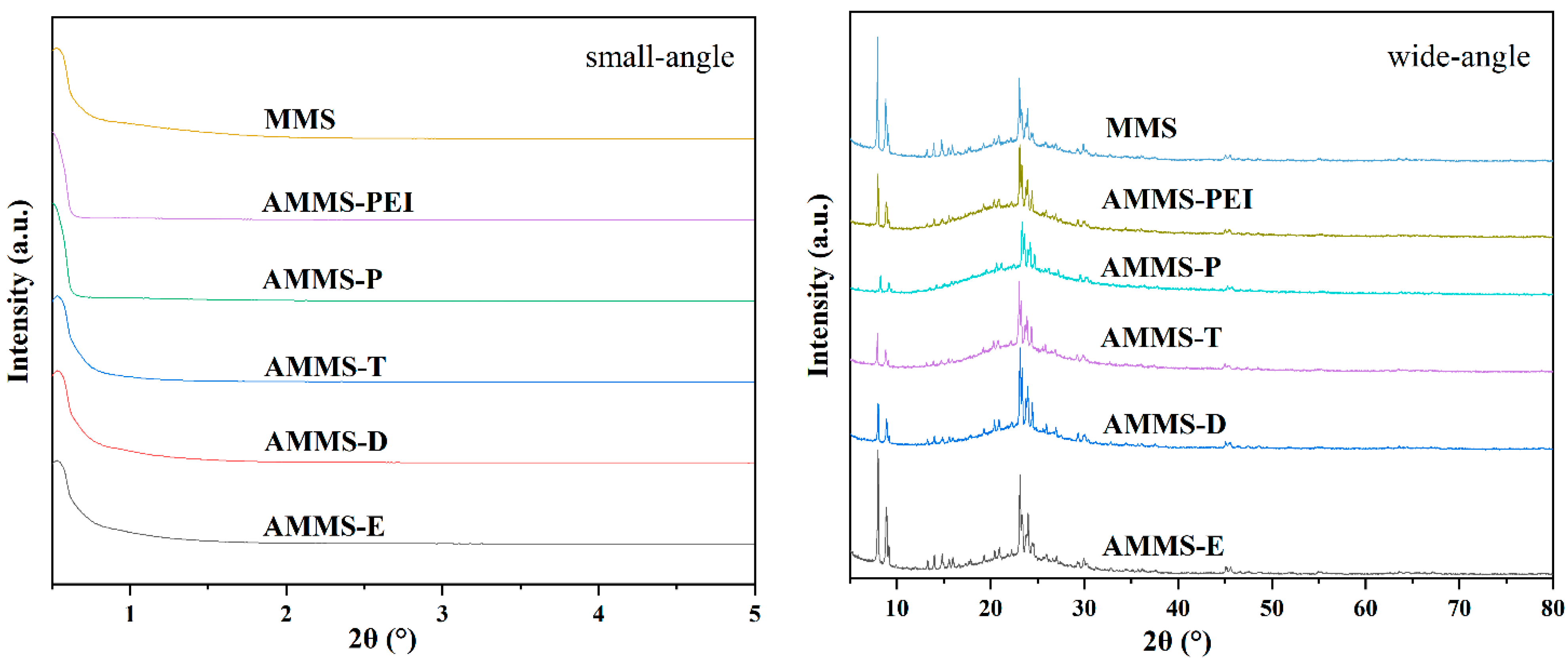
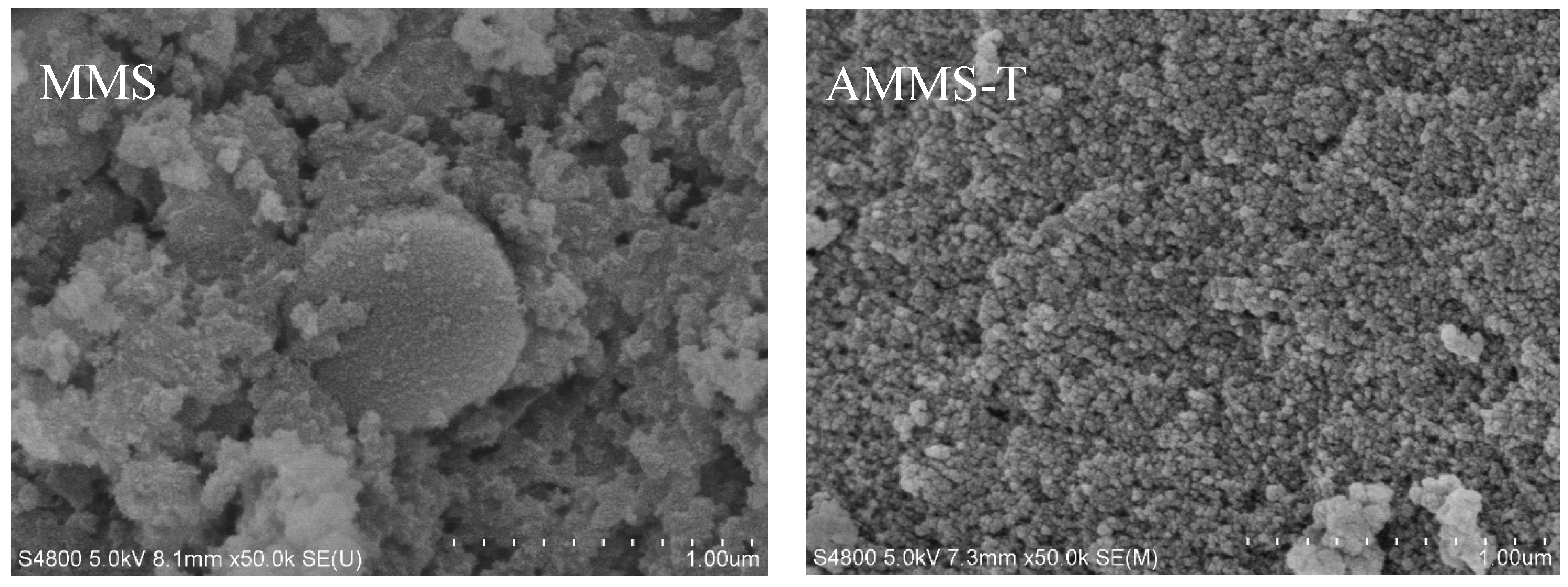
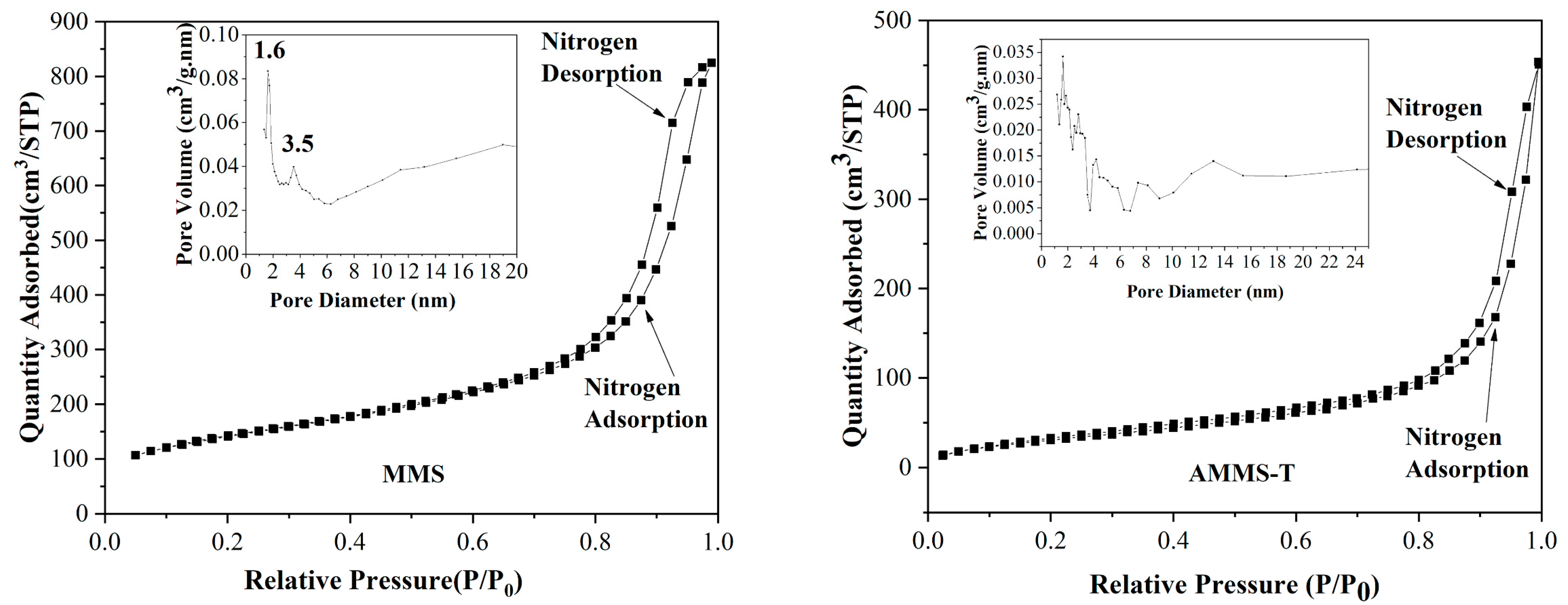

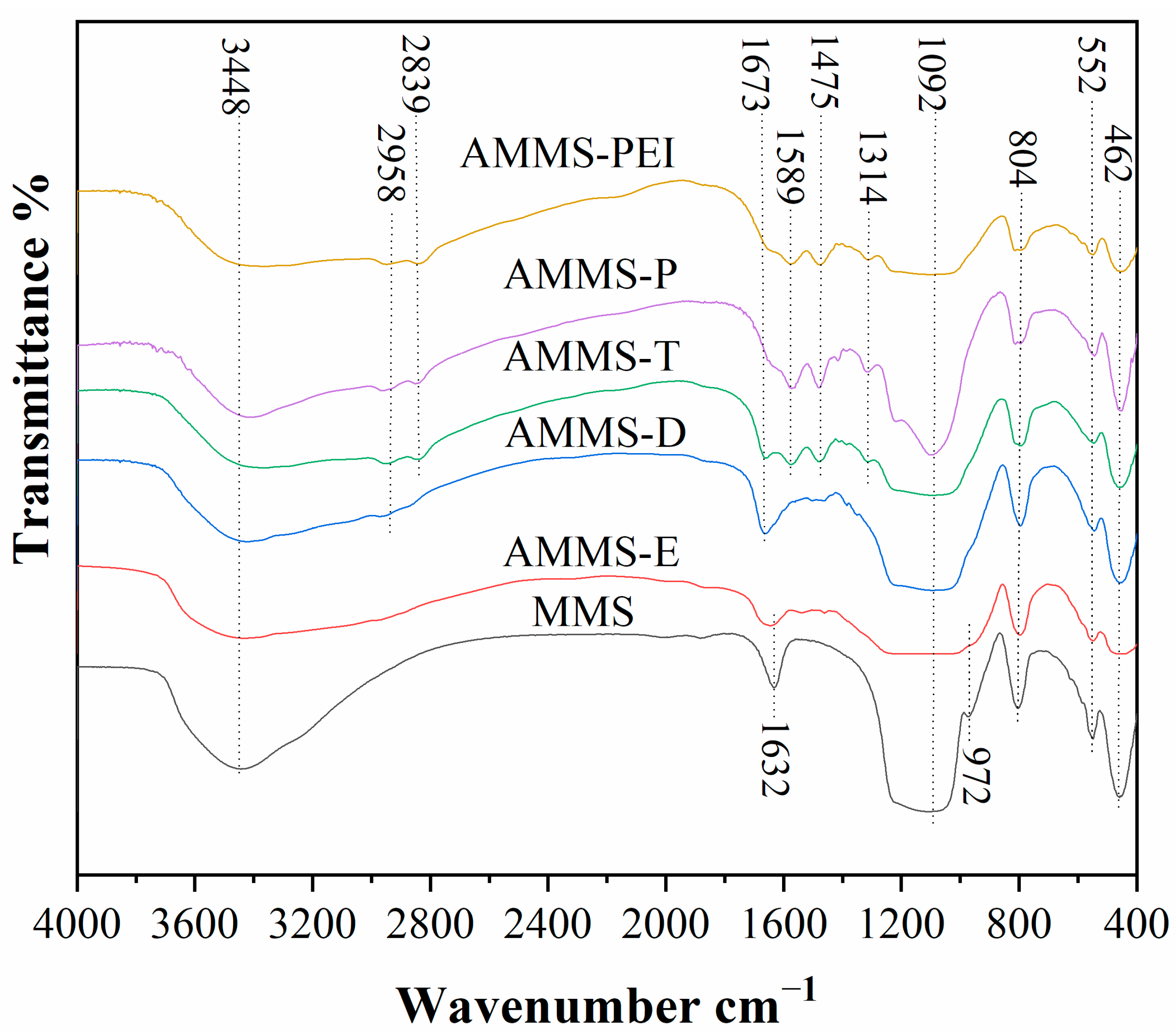


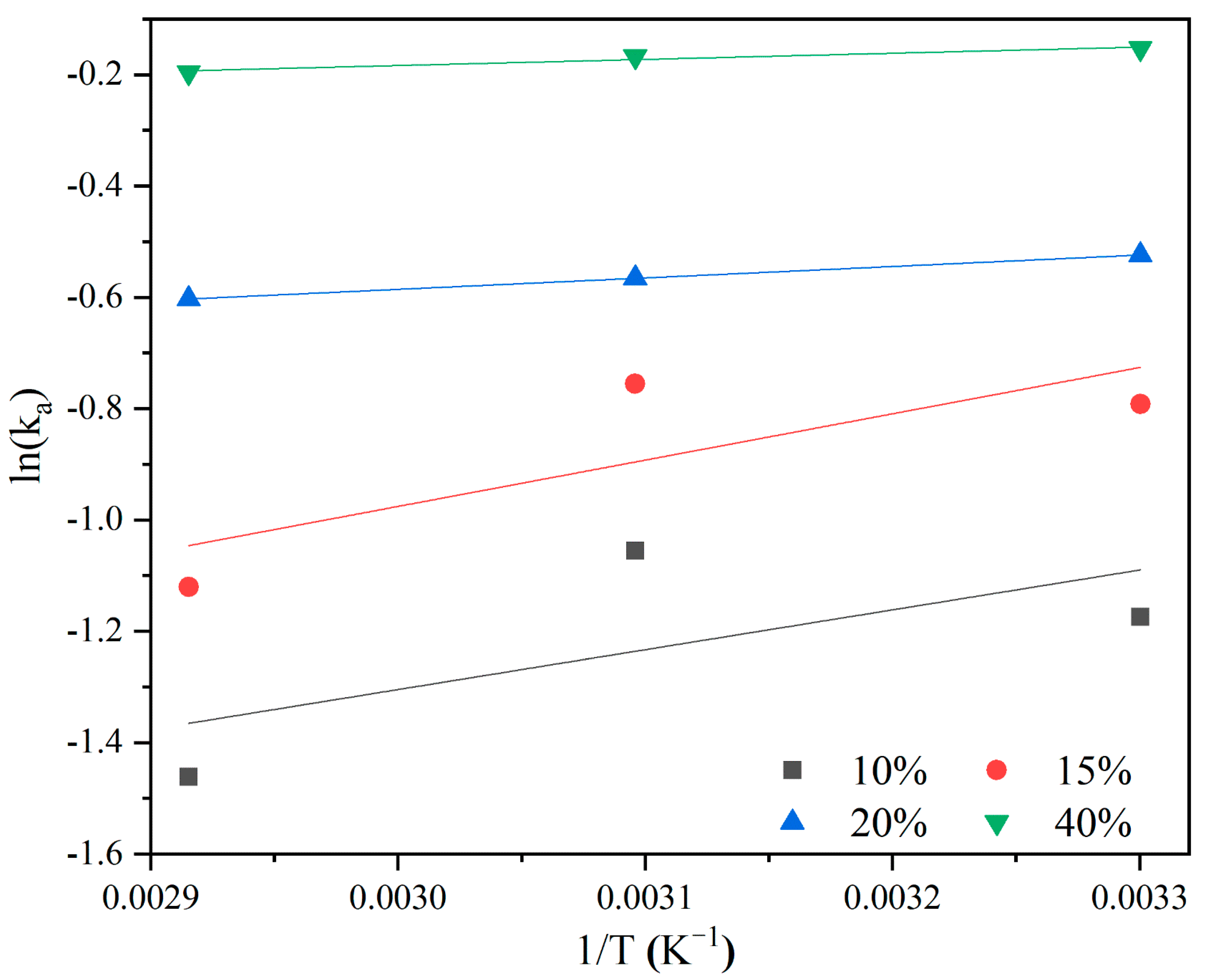

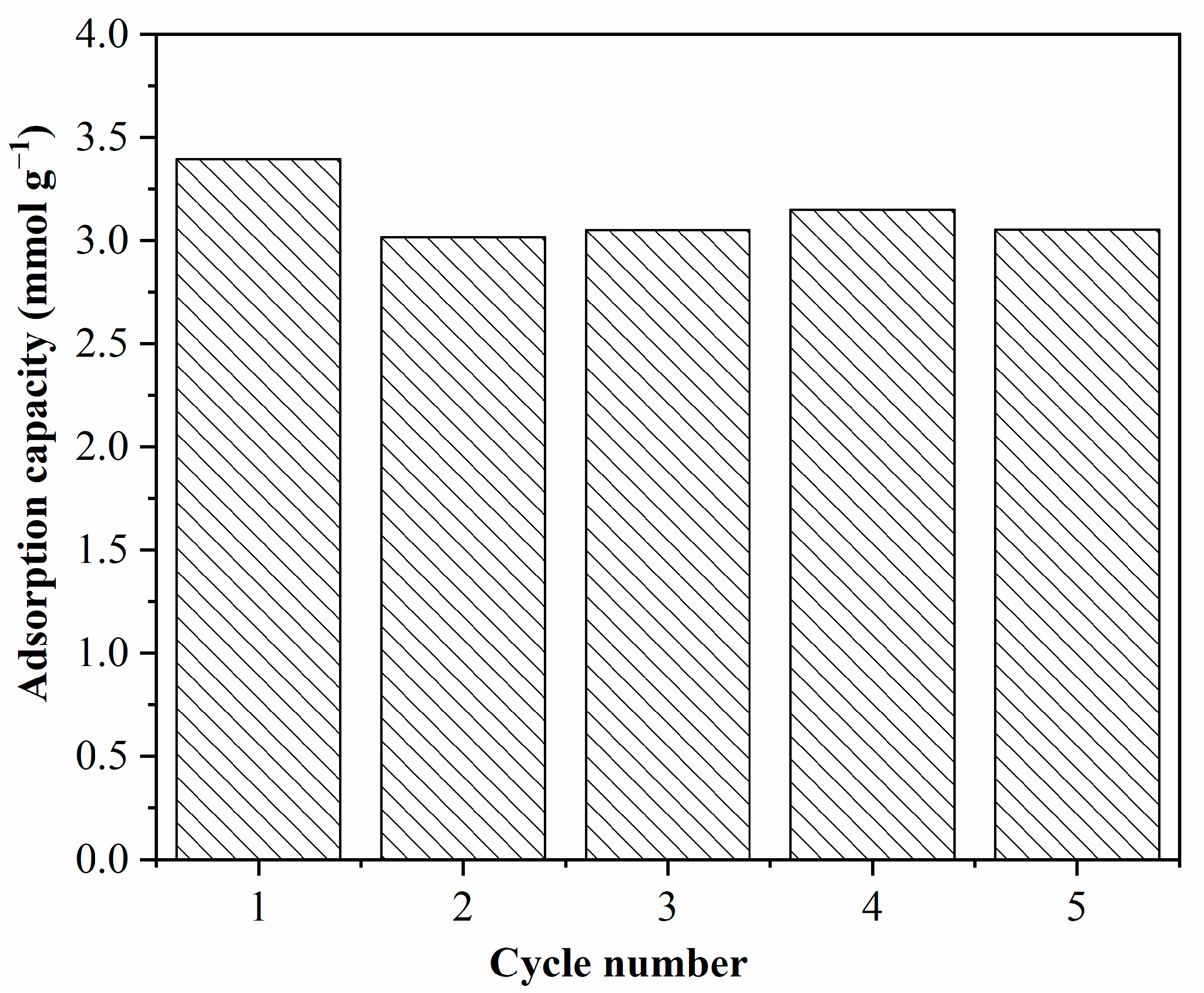
| Chemical Name | mol. wt. | Purities | CAS-No. | Sources |
|---|---|---|---|---|
| Tetrapropylammonium hydroxide solution | 203.36 | 25.0% | 4499-86-9 | Macklin Biochemical Co., Ltd. (Shanghai, China) |
| Aluminium isopropoxide | 204.25 | ≥98.0% | 555-31-7 | BASF Biotechnology Co., Ltd. (Hangzhou, China) |
| Tetraethylorthosilicate | 208.33 | 98.0% | 78-10-4 | Aladdin Biochemical Technology Co., Ltd. (Shanghai, China) |
| Polyethylene-polypropylene glycol | ~5800 | 9003-11-6 | Macklin Biochemical Co., Ltd. (Shanghai, China) | |
| Hydrochloric acid | 36.46 | 35.0% | 7647-01-0 | Fuzhou Yihua Chemical Co., Ltd. (Fuzhou, China) |
| n-Butanol | 74.12 | ≥99.5% | 71-36-3 | Sinopharm Chemical Reagent Co., Ltd. (Shanghai, China) |
| Ethylenediamine | 60.1 | ≥99.0% | 107-15-3 | Sinopharm Chemical Reagent Co., Ltd. (Shanghai, China) |
| Diethylenetriamine | 103.17 | 99.0% | 111-40-0 | Aladdin Biochemical Technology Co., Ltd. (Shanghai, China) |
| Tetraethylenepentamine | 189.30 | 98.0% | 112-57-2 | Aladdin Biochemical Technology Co., Ltd. (Shanghai, China) |
| Pentaethylenehexamine | 232.38 | 98.0% | 4067-16-7 | Macklin Biochemical Co., Ltd. (Shanghai, China) |
| Ethylene imine polymer | 600 | 99.0% | 9002-98-6 | Aladdin Biochemical Technology Co., Ltd. (Shanghai, China) |
| Ethanol | 46.07 | ≥99.7% | 64-17-5 | Sinopharm Chemical Reagent Co., Ltd. (Shanghai, China) |
| Carbon dioxide | 44.0 | ≥99.999% | 124-38-9 | Fuzhou Yuanhua Chemical Co., Ltd. (Fuzhou, China) |
| Nitrogen | 28.0 | 99.999% | 7727-37-9 | Fuzhou Yuanhua Chemical Co., Ltd. (Fuzhou, China) |
| Sample | Surface Area (m2·g−1) | Total Pore Volume (cm3·g−1) | Micropore Volume | Mesopore Volume | Average Pore Diameter (nm) |
|---|---|---|---|---|---|
| MMS | 498 | 1.261 | 0.170 | 1.091 | 3.5 |
| AMMS-E | 404 | 1.445 | 0.080 | 1.365 | 3.5 |
| AMMS-D | 314 | 1.351 | 0.140 | 1.211 | 1.2 |
| AMMS-T | 121 | 0.770 | 0.080 | 0.690 | 1.6 |
| AMMS-P | 88 | 0.500 | 0.050 | 0.450 | 1.4 |
| AMMS-PEI | 9.7 | 0.084 | 0 | 0.084 | 3.3 |
| Adsorbent | Amine-Modified Material | qa (mmol-CO2/g-Adsorbent) | ||
|---|---|---|---|---|
| 303 K | 323 K | 343 K | ||
| MMS * | 0.99 | 0.45 | 0.33 | |
| AMMS-E * | EDA | 0.79 | 0.47 | 0.37 |
| AMMS-D | DETA | 0.70 | 0.67 | 0.51 |
| AMMS-T | TEPA | 2.23 | 2.90 | 3.32 |
| AMMS-P | PEHA | 1.41 | 1.95 | 2.65 |
| AMMS-PEI | PEI | 0.74 | 1.11 | 1.75 |
| Support | Amine Type | Temp. K | CO2 Partial Pressure (bar) | CO2 Adsorption (mmol-CO2/g-ads) | Ref. |
|---|---|---|---|---|---|
| HMS | PEI | 318 | 1 | 2.40 | [39] |
| MS-3040 (Microspherical Silica) | PEI | 358 | 0.95 | 3.26 | [40] |
| SBA-15 | TEPA | 333 | 0.15 | 2.15 | [41] |
| Zn/CoZIF | PEI | 298 | 1 | 1.82 | [42] |
| SFM-0.83-100-5.2 | PEI | 348 | 0.15 | 2.48 | [43] |
| Silica | PEI | 353 | 0.15 | 2.86 | [44] |
| Mesoporous PCN-777 | PEI | 298 | 0.25 | 1.41 | [45] |
| MOF | PEI | 298 | 1 | 2.84 | [46] |
| MCM550 (Mesoporous Monolithic) | PEI | 348 | 0.12 | 1.89 | [47] |
| AMMS-T | TEPA | 343 | 0.10 | 3.32 | This work |
| T (K) | C0 (vol.%) | Avrami Model | qa (mmol/g) | |||
|---|---|---|---|---|---|---|
| Ka | qe (mmol/g) | n | R2 | |||
| 303 | 10 | 0.309 | 2.09 | 2.000 | 0.996 | 2.235 |
| 303 | 15 | 0.453 | 1.486 | 1.681 | 0.995 | 1.576 |
| 303 | 20 | 0.592 | 1.156 | 0.543 | 0.974 | 1.133 |
| 303 | 40 | 0.858 | 0.851 | 1.024 | 0.982 | 1.189 |
| 323 | 10 | 0.348 | 2.685 | 1.813 | 0.988 | 2.900 |
| 323 | 15 | 0.470 | 1.585 | 1.731 | 0.991 | 1.775 |
| 323 | 20 | 0.568 | 1.758 | 0.653 | 0.989 | 1.744 |
| 323 | 40 | 0.846 | 2.291 | 1.880 | 0.988 | 2.667 |
| 343 | 10 | 0.232 | 3.160 | 1.982 | 0.999 | 3.322 |
| 343 | 15 | 0.326 | 2.074 | 1.549 | 0.995 | 2.368 |
| 343 | 20 | 0.547 | 1.947 | 1.750 | 0.996 | 2.322 |
| 343 | 40 | 0.822 | 2.822 | 1.882 | 0.995 | 3.078 |
| CO2 Concentration (vol.%) | A (min−1) | Ea (KJ/mol) | R2 |
|---|---|---|---|
| 10 | 0.031696 | −5.81806 | 0.43709 |
| 15 | 0.03105 | −6.76534 | 0.63287 |
| 20 | 0.300659 | −1.66947 | 0.99993 |
| 40 | 0.597542 | −0.89788 | 0.94752 |
Publisher’s Note: MDPI stays neutral with regard to jurisdictional claims in published maps and institutional affiliations. |
© 2022 by the authors. Licensee MDPI, Basel, Switzerland. This article is an open access article distributed under the terms and conditions of the Creative Commons Attribution (CC BY) license (https://creativecommons.org/licenses/by/4.0/).
Share and Cite
Chen, Y.; Wu, J.; Wang, X.; Liu, M.; Liu, Y. Synthesis, Characterization and Application of Amine-Functionalized Hierarchically Micro-Mesoporous Silicon Composites for CO2 Capture in Flue Gas. Molecules 2022, 27, 3429. https://doi.org/10.3390/molecules27113429
Chen Y, Wu J, Wang X, Liu M, Liu Y. Synthesis, Characterization and Application of Amine-Functionalized Hierarchically Micro-Mesoporous Silicon Composites for CO2 Capture in Flue Gas. Molecules. 2022; 27(11):3429. https://doi.org/10.3390/molecules27113429
Chicago/Turabian StyleChen, Yilan, Junjie Wu, Xin Wang, Minyi Liu, and Yamin Liu. 2022. "Synthesis, Characterization and Application of Amine-Functionalized Hierarchically Micro-Mesoporous Silicon Composites for CO2 Capture in Flue Gas" Molecules 27, no. 11: 3429. https://doi.org/10.3390/molecules27113429







